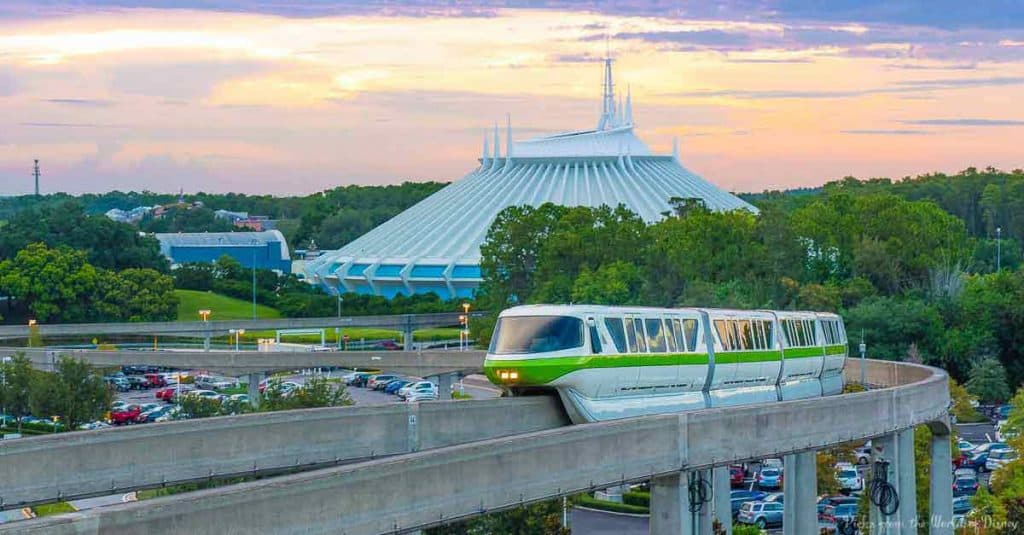
6. Speed needs
While monorails have the potential to go as fast as 70 miles per hour, the maximum allowable speed during hours of operation typically ranges at around 40 miles per hour or even less. Some parts of the system stay at a speed of just 15 miles per hour. The motors boast 904 horsepower, running off a 600-volt electrical powered system in which metallic buss bars pick up electricity while moving along the track’s beam.
In the less likely scenario discussed earlier, in which a monorail train breaks down and must be moved to the maintenance track (or if there is another emergency or power failure), three diesel powered tow tractors are at the ready to help move the monorail trains along to the maintenance area.
5. What’s in a track?
Take a good look at the track beam in which the monorail trains travel by and it may surprise you to realize it’s only 26 inches wide. That’s just two inches more than two feet! Monorail track beams are supported by tapered columns, constructed in sets of six, post-tensioned, and then spaced around 110 feet apart from each to form an overall single structure spanning 600 feet.
Another surprising fact is learning what these beams are made out of. At the center of each beam is a polystyrene (aka Styrofoam) core, which has then been encased in concrete and steel, adding both lightness and sturdiness to the overall structure. Original monorail beams were constructed far north in the state of Washington and then shipped via trucks to sunny central Florida.
4. Train car specs
Walt Disney World Monorail trains span a total of 203 feet in length and sport an overall height range of just over 10 feet, five inches. Each is comprised of six individual cars that have the capacity to carry up to 364 passengers at a time. Currently there are 12 different monorail trains in use today at Disney World, each one individualized by its own unique colored strip running horizontally down the side of its connected cars.
These colors are black, red, yellow, blue, green, lime, orange, coral, silver, peach, gold, and teal. Monorails rely on commercial grade truck tires for their wheels as they glide along the tracks. Each one has been estimated to drive well over 60,000 miles annually.
3. Escape plan
While monorail emergencies are thankfully uncommon, Disney has devised a strategic escape plan in the event that there is ever an immediate need for passengers to evacuate. Three different escape routes have been implemented into monorail cars themselves to make this process go smoothly, based on the emergency at hand and quickest way to safety in consideration of that particular event. For example, each individual train car contains a window that can be opened internally, allowing passengers to crawl out to safety. An additional hidden trapdoor can be found on the roof of the train car by removing part of the ceiling.
There’s also a door at the exterior of the monorail that can be opened by releasing air pressure. In the event of necessary and immediate evacuation, the process is usually the same—guests head for the roof of the monorail train car and are then assisted by local officials and authorities to safety. They may even be instructed to walk across the top to the front car where the pilot attaches a rope to be used to crawl down to the lower beam!
2. Incidents

While occurrences are rare, we cannot say that the Disney Monorail System hasn’t seen its fair share of incidents over the years. Back in 1985 a fire, said to be caused by a flat tire and the impact of friction, broke out in the rear car of one of the monorails, leading to the evacuation of passengers by kicking out the windows and heading to the top of the train.
Nearly three decades later in 2014 a power failure resulted in one Epcot Line train car to stall on the beam. This left passengers trapped inside for well over an hour before being evacuated by Disney personnel and the local fire department. But it was in July of 2009 that the Walt Disney World Monorail System saw its first and only fatal incident to date—a crash involving the Pink and Purple train cars. While several sustained injuries, one of the pilots sadly lost his life in the collision. As a result, Colors Purple and Pink were the only two monorail colors to ever be retired at Disney World.
1. A continued work-in-progress
The monorail systems at various Disney Parks throughout the world are constant works-in-progress. Overall developments have come a long way since the Disneyland inception of the new-style monorails, and they aren’t over yet. As recently as June 2014 a new automated process has been underway to provide for more efficient service and safety practices. While pilots remain seated in the front cab of each monorail train, their roles have changed to more of a supervisory nature, initiating direct control only in the event of an emergency or necessary intervention.
There have been many new and emerging creative methods for traveling about Walt Disney World Resort in recent years. From the introduction to Minnie Van services by Lyft to the recently launched Disney Skyliner gondolas, and even improvements to the complimentary shuttle services; possibilities for growth and expansion with Disney are seemingly unending. But despite all that, the Walt Disney World Monorail System continues to be the most timeless classic must-do transportation endeavor for countless park goers each and every year.

